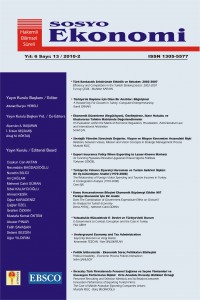Öz
Around the world economies, underground economy is a fiscal problem peculiar to the developing countries. But almost all countries, independent of whether developed, developing or transition, face a remarkably large size of the underground economy. Underground economy has two main disadvantages: Not only it cut downs the tax revenues but also it causes the tax equity to worse off and threatens the legitimacy of the tax system. So, it emerges for government interventions like tax policy, direct regulations or institutional arrangements. In this paper, we expand the analysis of underground economy one step further to put forward a remedy for the underground economy: Some efforts must be made to increase tax compliance such as, establishing the simplicity of the tax system, encouraging the compliant motives of the taxpayers, powering different behaviour patterns with respect to different income levels and stipulating efficient administration of the reforms.
Anahtar Kelimeler
Kaynakça
- Brooks, N. (2001), “Key Issues in Income Tax: Challenges of Tax Administration and Compliance”, Asian Development Bank Tax Conference, September 8, 2001.
- CCRA (2002), “The Role and Strategies of the Tax Administration in Developing Countries: Methods to Promote Voluntary Compliance, Inter American Center of Tax Administrations”, Third Regional Training Workshop on International Taxation, December 3, 2002, Brasilia, Brazil.
- Gylys, P. (2005), “Economy, Anti-Economy, Underground Economy: Conceptual and Terminological Problems”, Ekonomika, 72, 1–11.
- Internal Revenue Service (2005), Understanding the Tax Gap, <http://www.irs.gov/newsroom/article/0,,id=137246,00.html>, 07.04.2007.
- OECD (2001), “Principles of Good Tax Administration – Practice Note”, OECD-Tax Guidance Series, No: GAP001.
- Özsoylu, A. F. (1996), Türkiye’de Kayıtdışı Ekonomi, İstanbul: Bağlam Yayıncılık.
- Schneider, F. (2004), “The Size of the Shadow Economies of 146 Countries all over the World: First Results over the Period 1999 to 2003”, IZA Discussion Paper, No: 1431, Bonn: IZA.
- Schneider, F., D. Enste (2000), “Shadow Economies: Size, Causes and Consequences”, Journal of Economic Literature 38 (1), 77–114.
- Silvani, C., K. Baer (1997) “Designing Tax Administration Reform Strategy: Experiences and Guidelines”, IMF Working Paper Series WP/97/30, Washington D.C.:The International Monetary Fund.
- Smith, P. (1994) “Assessing the Size of the Underground Economy: The Statistics Canada Perspectives”, Canadian Economic Observer 11, 16–33.
- Tanzi, V., G. Tsibouris (2000), “Fiscal Reform over Ten Years of Transition”, IMF Working Paper Series WP/00/113, Washington D.C.:The International Monetary Fund.
- Trasberg, V. (2004), “Tax Administration and Shadow Economy in EU New Members”, Societa Italiana di Economia Pubblica Working Paper 313, Pavia: University of Pavia.
- Varquez, J. M., A. Timofeev (2005), “Choosing Between Centralized Models of Tax Administration”, ISP Working Paper, No: 05–02.
Öz
Around the world economies, underground economy is a fiscal problem peculiar to the developing countries. But almost all countries, independent of whether developed, developing or transition, face a remarkably large size of the underground economy. Underground economy has two main disadvantages: Not only it cut downs the tax revenues but also it causes the tax equity to worse off and threatens the legitimacy of the tax system. So, it emerges for government interventions like tax policy, direct regulations or institutional arrangements. In this paper, we expand the analysis of underground economy one step further to put forward a remedy for the underground economy: Some efforts must be made to increase tax compliance such as, establishing the simplicity of the tax system, encouraging the compliant motives of the taxpayers, powering different behaviour patterns with respect to different income levels and stipulating efficient administration of the reforms.
Anahtar Kelimeler
Kaynakça
- Brooks, N. (2001), “Key Issues in Income Tax: Challenges of Tax Administration and Compliance”, Asian Development Bank Tax Conference, September 8, 2001.
- CCRA (2002), “The Role and Strategies of the Tax Administration in Developing Countries: Methods to Promote Voluntary Compliance, Inter American Center of Tax Administrations”, Third Regional Training Workshop on International Taxation, December 3, 2002, Brasilia, Brazil.
- Gylys, P. (2005), “Economy, Anti-Economy, Underground Economy: Conceptual and Terminological Problems”, Ekonomika, 72, 1–11.
- Internal Revenue Service (2005), Understanding the Tax Gap, <http://www.irs.gov/newsroom/article/0,,id=137246,00.html>, 07.04.2007.
- OECD (2001), “Principles of Good Tax Administration – Practice Note”, OECD-Tax Guidance Series, No: GAP001.
- Özsoylu, A. F. (1996), Türkiye’de Kayıtdışı Ekonomi, İstanbul: Bağlam Yayıncılık.
- Schneider, F. (2004), “The Size of the Shadow Economies of 146 Countries all over the World: First Results over the Period 1999 to 2003”, IZA Discussion Paper, No: 1431, Bonn: IZA.
- Schneider, F., D. Enste (2000), “Shadow Economies: Size, Causes and Consequences”, Journal of Economic Literature 38 (1), 77–114.
- Silvani, C., K. Baer (1997) “Designing Tax Administration Reform Strategy: Experiences and Guidelines”, IMF Working Paper Series WP/97/30, Washington D.C.:The International Monetary Fund.
- Smith, P. (1994) “Assessing the Size of the Underground Economy: The Statistics Canada Perspectives”, Canadian Economic Observer 11, 16–33.
- Tanzi, V., G. Tsibouris (2000), “Fiscal Reform over Ten Years of Transition”, IMF Working Paper Series WP/00/113, Washington D.C.:The International Monetary Fund.
- Trasberg, V. (2004), “Tax Administration and Shadow Economy in EU New Members”, Societa Italiana di Economia Pubblica Working Paper 313, Pavia: University of Pavia.
- Varquez, J. M., A. Timofeev (2005), “Choosing Between Centralized Models of Tax Administration”, ISP Working Paper, No: 05–02.
Ayrıntılar
| Birincil Dil | İngilizce |
|---|---|
| Bölüm | Makaleler |
| Yazarlar | |
| Yayımlanma Tarihi | 1 Aralık 2010 |
| Gönderilme Tarihi | 12 Aralık 2014 |
| Yayımlandığı Sayı | Yıl 2010 Cilt: 13 Sayı: 13 |


